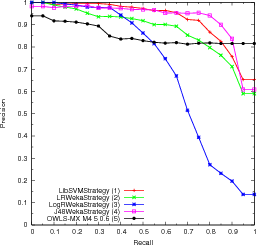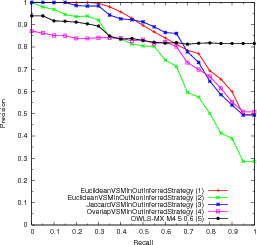Overview
OWL-S iMachter performs hybrid Semantic Web service matchmaking. The main features of the program are the following:
- allows the user to define customized matchmaking strategies
- uses similarity measures to improve the matchmaking performance
- includes an evaluation framework
- calculates precision vs. recall graphs
- allows the user to immediately plot the results using Gnuplot
- is simple to use
- is extensible with related matchmaking techniques in the field
How to use
Typically, the following steps are necessary to perform customized matchmaking:
1. Define an iSPARQL strategy.
A simple strategy could look as follows:
================================================
1 PREFIX rdfs: <http://www.w3.org/2000/01/rdf-schema#>
2 PREFIX owl: <http://www.w3.org/2002/07/owl#>
3 PREFIX rdf: <http://www.w3.org/1999/02/22-rdf-syntax-ns#>
4 PREFIX service: <http://www.daml.org/services/owl-s/1.1/Service.owl#>
5 PREFIX profile: <http://www.daml.org/services/owl-s/1.1/Profile.owl#>
6 PREFIX simpack: <java:ch.uzh.ifi.isparql.apf.simpack.>
7
8 SELECT ?service ?sim
9 WHERE {
10 ?service service:presents ?serviceProfile .
11 ?serviceProfile profile:serviceName ?serviceName .
12 <http://localhost/book_price_service.owls#BOOK_PRICE_SERVICE> service:presents ?queryProfile .
13 ?queryProfile profile:serviceName ?queryName .
14
15 IMPRECISE {
16 ?sim simpack:levenshtein (?serviceName ?queryName)
17 }
18
19 } ORDER BY DESC (?sim)
================================================
As mentioned earlier, the creation and evaluation of arbitrary complex strategies is possilble. Have a look at a more complex strategy, such as the following:
================================================
1 PREFIX rdfs: <http://www.w3.org/2000/01/rdf-schema#>
2 PREFIX owl: <http://www.w3.org/2002/07/owl#>
3 PREFIX rdf: <http://www.w3.org/1999/02/22-rdf-syntax-ns#>
4 PREFIX service: <http://www.daml.org/services/owl-s/1.1/Service.owl#>
5 PREFIX profile: <http://www.daml.org/services/owl-s/1.1/Profile.owl#>
6 PREFIX simpack: <java:ch.uzh.ifi.isparql.apf.simpack.>
7
8 SELECT ?service ?sim
9 WHERE {
10 ?service service:presents ?serviceProfile .
11 ?serviceProfile profile:serviceName ?serviceName .
12 ?serviceProfile profile:textDescription ?serviceTextDescription .
13 <http://localhost/book_price_service.owls#BOOK_PRICE_SERVICE> service:presents ?queryProfile .
14 ?queryProfile profile:textDescription ?queryTextDescription .
15 ?queryProfile profile:serviceName ?queryName .
16
17 IMPRECISE {
18 ?sim1 simpack:xingstroulia (?serviceName ?queryName) .
19 ?sim2 simpack:tfidf (?serviceTextDescription ?queryTextDescription) .
20 ?sim3 simpack:jaccardInputs (?serviceProfile ?queryProfile "true") .
21 ?sim4 simpack:jaccardOutputs (?serviceProfile ?queryProfile "true") .
22 ?sim simpack:score (0.0401 ?sim1 0.9488 ?sim2 0.1933 ?sim3 0.0843 ?sim4 -0.0396 1.0)
23 }
24
25 } ORDER BY DESC (?sim)
================================================
2. Define an iSPARQL property function.
For instance, for the virtual triple pattern simpack:levenshtein in the first strategy on line 16:
package ch.uzh.ifi.isparql.apf.simpack;
|
3. Customize evaluation run
Customize class MacroAveragingTest in the tests package by specifying the service knowledge base and the queries to be executed. Furthermore, add a line as follows:
strategies.add(new LevNStrategy());
This will execute the strategy defined by the LevNStrategy class. As a result, a file called eval.gp will be created, which can be plotted with Gnuplot.
4. Plot
Call the script gnuplot.sh to print the precision vs. recall curve(s) for this iSPARQL matchmaking strategy:
[peter@neverland]$ ./gnuplot.sh
This will open a window to display the curve.
License
iMatcher is licensed under LGPL.
Download
OWL-S iMatcher consists of two parts:
Datasets
- OWL-S TC v2 (created by Matthias Klusch et al., you can also download it from here)
Questions and Bug Reports
If you find bugs or you have problems with the code you cannot solve by yourself, please contact me via email.
References
- Christoph Kiefer, Abraham Bernstein. The Creation and Evaluation of iSPARQL Strategies for Matchmaking. Proceedings of the 5th European Semantic Web Conference (ESWC). Tenerife, Spain, June 1-5, 2008. to appear [pdf] [bibtex]
- Christoph Kiefer, Abraham Bernstein, and Markus Stocker. The Fundamentals of iSPARQL - A Virtual Triple Approach For Similarity-Based Semantic Web Tasks. Proceedings of the 6th International Semantic Web Conference (ISWC). Busan, Korea, November 11-15, 2007. [pdf] [bibtex]
Last modified March 15th, 2008 by Christoph Kiefer <kiefer at ifi.uzh.ch>
| 4905 |







